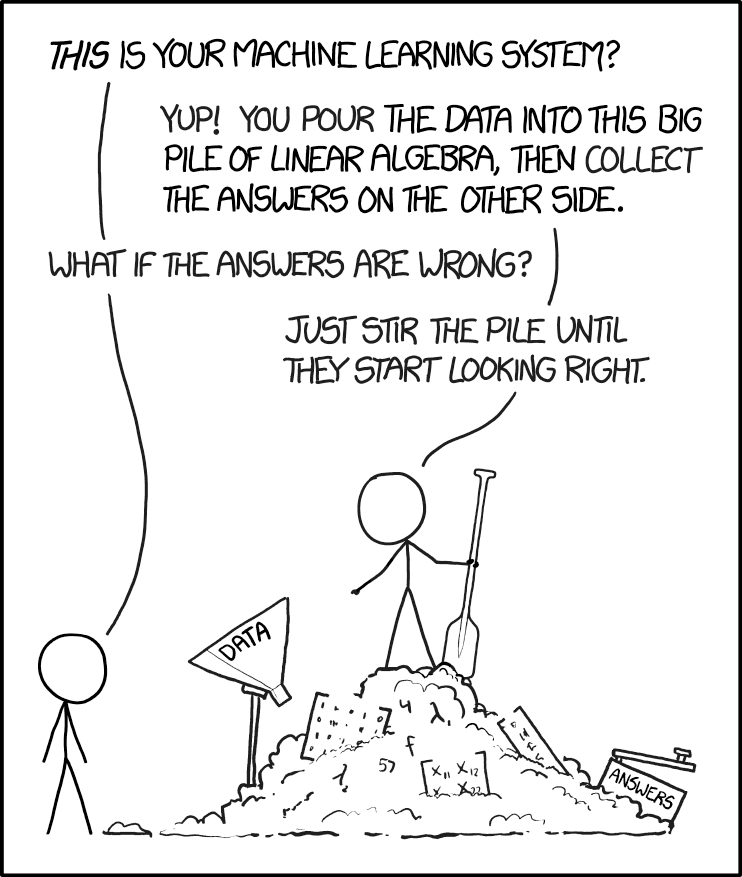For starters, machine learning is not magic. It might appear like magic when you see Google Photos automatically tagging all your family members correctly, down to the day of their birth. It might appear so when Siri or Alexa give a perfect response to your request. And the way AlphaZero plays chess is almost human!
But no, machine learning is not magic. I’d made a detailed argument about that in the second edition of my newsletter (subscribe if you haven’t already!).
One way to think of it is that the output of a machine learning model (which could be anything from “does this picture contain a cat?” to “is the speaker speaking in English?”) is the result of a mathematical formula, whose parameters are unknown at the beginning of the exercise.
As the system gets “trained” (of late I’ve avoided using the word “training” in the context of machine learning, preferring to use “calibration” instead. But anyway…), the hitherto unknown parameters of the formula get adjusted in a manner that the formula output matches the given data. Once the system has “seen” enough data, we have a model, which can then be applied on unknown data (I’m completely simplifying it here).
The genius in machine learning comes in setting up mathematical formulae in a way that given input-output pairs of data can be used to adjust the parameters of the formulae. The genius in deep learning, which has been the rage this decade, for example, comes from a 30-year old mathematical breakthrough called “back propagation”. The reason it took until a few years back for it to become a “thing” has to do with data availability, and compute power (check this terrific piece in the MIT Tech Review about deep learning).
Within machine learning, the degree of complexity of a model can vary significantly. In an ordinary univariate least squares regression, for example, there are only two parameters the system can play with (slope and intercept of the regression line). Even a simple “shallow” neural network, on the other hand, has thousands of parameters.
Because a regression has so few parameters, the kind of patterns that the system can detect is rather limited (whatever you do, the system can only draw a line. Nothing more!). Thus, regression is applied only when you know that the relationship that exists is simple (and linear), or when you are trying to force-fit a linear model.
The upside of simple models such as regression is that because there are so few parameters to be adjusted, you need relatively few data points in order to adjust them to the required degree of accuracy.
As models get more and more complicated, the number of parameters increases, thus increasing the complexity of patterns that can be detected by the system. Close to one extreme, you have systems that see lots of current pictures of you and then identify you in your baby pictures.
Such complicated patterns can be identified because the system parameters have lots of degrees of freedom. The downside, of course, is that because the parameters start off having so much freedom, it takes that much more data to “tie them down”. The reason Google Photos can tag you in your baby pictures is partly down to the quantum of image data that Google has, which does an effective job of tying down the parameters. Google Translate similarly uses large repositories of multi-lingual text in order to “learn languages”.
Like most other things in life, machine learning also involves a tradeoff. It is possible for systems to identify complex patterns, but for that you need to start off with lots of “degrees of freedom”, and then use lots of data to tie down the variables. If your data is small, then you can only afford a small number of parameters, and that limits the complexity of patterns that can be detected.
One way around this, of course, is to use your own human intelligence as a pre-processing step in order to set up parameters in a way that they can be effectively tuned by data. Gopi had a nice post recently on “neat learning versus deep learning“, which is relevant in this context.
Finally, there is the issue of spurious correlations. Because machine learning systems are basically mathematical formulae designed to learn patterns from data, spurious correlations in the input dataset can lead to the system learning random things, which can hamper its predictive power.
Data sets, especially ones that have lots of dimensions, can display correlations that appear at random, but if the input dataset shows enough of these correlations, the system will “learn” them as a pattern, and try to use them in predictions. And the more complicated your model gets, the harder it is to know what it is doing, and thus the harder it is to identify these spurious correlations!
And the thing with having too many “free parameters” (lots of degrees of freedom but without enough data to tie down the parameters) is that these free parameters are especially susceptible to learning the spurious correlations – for they have no other job.
Thinking about it, after all, machine learning systems are not human!


One thought on “Machine learning and degrees of freedom”